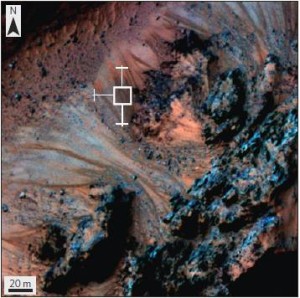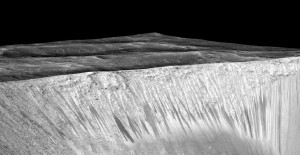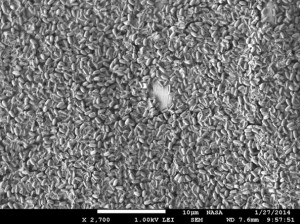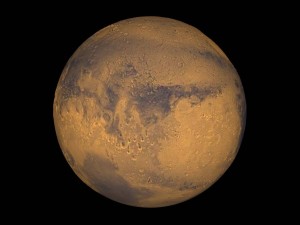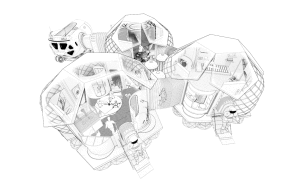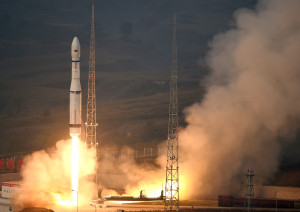Archive for September, 2015

Color-coded topographic map of Occator crater on Ceres produced from Dawn spacecraft imagery.
Blue is the lowest elevation, and brown is the highest. The crater, which is home to the brightest spots on Ceres, is approximately 56 miles (90 kilometers wide).
Credit: NASA/JPL-Caltech/UCLA/MPS/DLR/IDA
Data gleaned by NASA’s Dawn spacecraft at Ceres has provided another type of look at the puzzling Occator crater.
NASA has released a color-coded topographic map of the bright spots found within the 56 miles (90 kilometers wide) crater.
The topographic images of Occator (oh-KAH-tor) show the brightest spots and a cone-shaped 6-mile-high (4-kilometer-high) mountain.

This view, made using images taken by NASA’s Dawn spacecraft, features a tall conical mountain on Ceres.
Elevations span a range of about 5 miles (8 kilometers) from the lowest places in this region to the highest terrains. Blue represents the lowest elevation, and brown is the highest. The white streaks seen running down the side of the mountain are especially bright parts of the surface.
Credit: NASA/JPL-Caltech/UCLA/MPS/DLR/IDA/PSI
Scientists are still trying to identify processes that could produce these and other unique “Cerean” phenomena.
Closer looks slated
The Dawn spacecraft is currently orbiting Ceres at an altitude of 915 miles (1,470 kilometers). At that height the spacecraft will image the entire surface of the dwarf planet up to six times in this phase of the mission.
Each imaging cycle takes 11 days.
Starting in October and continuing into December, Dawn will descend to its lowest and final orbit, an altitude of 230 miles (375 kilometers).
The spacecraft will continue imaging Ceres and taking other data at higher resolutions than ever before at this last orbit. It will remain operational at least through mid-2016.
Twofer targeting
Dawn is the first mission to reach a dwarf planet, and the first to orbit two distinct extraterrestrial targets: It arrived at Ceres on March 6, 2015 and carried out observations of Vesta in 2011 and 2012.
Dawn’s mission is managed by the Jet Propulsion Laboratory (JPL) for NASA’s Science Mission Directorate in Washington.
More information about Dawn is available at the following sites:

NASA’s Mars rover Curiosity Mars Hand Lens Imager (MAHLI), located on the turret at the end of the rover’s robotic arm, captured this image on September 26, 2015, Sol 1116.
Credit: NASA/JPL-Caltech/MSSS
Today is Sol 1119 for the Mars Curiosity rover mission.
Over last weekend, a mini-drill has cleared the way for drilling “Big Sky.”
“The hope is that this location will provide a good sample of the ‘typical’ rock in the area to compare with some of the interesting alteration we’ve been seeing,” reports Ryan Anderson, a planetary scientist at the USGS Astrogeology Science Center in Flagstaff, Arizona.

Roughly an hour later, this image was taken by Mars rover Curiosity’s Mars Hand Lens Imager (MAHLI).
Credit: NASA/JPL-Caltech/MSSS
Along with the drilling, there will be a number of Mars Hand Lens Imager (MAHLI) documentation images taken of the hole from varying distances and angles.
Anderson reports that on sol 1120, the rover’s Chemistry & Camera (ChemCam) will target the drill tailings, along with the targets “Devil’s Basin,” “Livingston,” and “Deadwood.”
Curiosity’s Mastcam is slated to document the drill hole and all of the ChemCam targets. Then, later in the day on sol 1120, Navcam and Mastcam both have some atmospheric observations.
The robot’s Dynamic Albedo of Neutrons (DAN), the Radiation Assessment Detector (RAD), and the Rover Environmental Monitoring Station (REMS) are scheduled to perform routine monitoring, Anderson adds.
Actual dates of planned rover activities are subject to change due to a variety of factors related to the Martian environment, communication relays and rover status.

RSL activity in the central peaks of Horowitz crater and associated CRISM spectra.
Credit: Lujendra Ojha, et al./Nature Geoscience
Mars researchers offered today the strongest proof yet that there is “intermittent flowing liquid water” present on the Red Planet.
That prospect bolsters the chance that Mars may well be an extraterrestrial address for life. Furthermore, it offers future human explorers sites to look for Martian life and might help expeditionary crews sustain their presence on the planet.
The new evidence comes from work led by Lujendra Ojha of the Georgia Institute of Technology. A group of experts made use of instruments onboard NASA’s Mars Reconnaissance Orbiter (MRO): the High Resolution Imaging Science Experiment (HiRISE) and the Compact Reconnaissance Imaging Spectrometer for Mars (CRISM).
Focus of attention: RSL
The focus of attention for the orbiting gear was recurring slope lineae or RSL for Mars short-hand.
RSL form and snake down steep slopes on the planet during warm seasons when temperatures exceed -10 degrees Fahrenheit (-23 degrees Celsius). They disappear at colder times during the Martian year.
Measured were spectral signatures of hydrated minerals on slopes where the puzzling RSL are found on Mars.
Ojha reported today that spectral signatures of hydrated salts were visible in many RSL if they were relatively wide in diameter. The clincher came when the researchers looked at the same locations when RSL weren’t visible and the hydration signatures had disappeared.
Briny, rather than pure
“Something is hydrating these salts, and it appears to be these streaks that come and go with the seasons,” Ojha stated in a university press release.
“This means the water on Mars is briny, rather than pure. It makes sense because salts lower the freezing point of water. Even if RSL are slightly underground, where it’s even colder than the surface temperature, the salts would keep the water in a liquid form and allow it to creep down Martian slopes,” Ojha explains.
The researchers believe that the signatures are caused by previously discovered hydrated minerals called perchlorates. This new study, however, detected perchlorates in entirely different areas from where earlier landers explored. This is also the first time perchlorates have been identified from orbit.

NASA Mars Reconnaissance Orbiter’s HiRISE image of recurring slope lineae in Melas Chasma, Valles Marineris. Arrows point out tops and bottoms of a few lineae.
Credit: NASA/JPL-Caltech/University of Arizona
“This is the first spectral detection that unambiguously supports our liquid water-formation hypotheses for RSL,” Ojha adds.
Contemporary Mars
The Mars RSL team also includes researchers from NASA Ames Research Center, the Johns Hopkins University Applied Physics Laboratory, University of Arizona, Southwest Research Institute and Laboratoire de Planétologie et Géodynamique.
Their collective work appears in the paper, “Spectral evidence for hydrated salts in recurring slope lineae on Mars,” published in the journal Nature Geoscience.
“Determining whether liquid water exists on the Martian surface is central to understanding the hydrologic cycle and potential for extant life on Mars,” they write in the research paper.
“These results strongly support the hypothesis that seasonal warm slopes are forming liquid water on contemporary Mars. The spectral identification of perchlorate in association with RSL also suggests that the water is briny rather than pure,” the paper notes.
Additionally, the paper calls for “further astrobiological characterization and exploration of these unique regions on Mars.” However, the scientists do caution that while there are transiently wet conditions near surface on Mars, the water activity in perchlorate solutions “may be too low to support known terrestrial life.”
What next?
So given this new research, what next?
James Wray, Georgia Tech assistant professor and advisor to the university-led work, told Inside Outer Space:
“Personally, I think we could learn a lot about RSL from landing ‘near’ them…far enough away that they’re outside the landing uncertainty ellipse…and then driving close enough to image, but not to touch.”
Wray said that from orbit there’s no way to watch a given RSL evolve from one hour to the next, day after day, to determine when they are active.
“We could do this easily on the ground, even from a stationary lander,” Wray said. “Of course, eventually we will want to know more about their chemistry and organic content, if any, which would likely require contact science using a sterilized probe.”

RSL exploration zone. THEMIS daytime-IR mosaic with proposed human survey zone (blue circle) and features of interest.
Credit: A. McEwen, et al.
Human exploration sites
Next month, the “First Landing Site/Exploration Zone Workshop for Human Missions to the Surface of Mars” is being held at the Lunar and Planetary Institute in Houston, Texas.
One favorable zone advocated for human exploration is Eastern Melas Chasm. In work spearheaded by Alfred McEwen at the University of Arizona, that locale meets a number of criteria, including access to RSL.
Still to be determined, however, is whether or not RSL can produce useable water for human crews, McEwen and his colleagues explain. If Eastern Melas is considered a promising region for astronauts to inspect, then more CRISM and HIRISE coverage by MRO is warranted. A future orbiter could provide important new observations as well, they suggest.
Major priority
Similarly, Hale crater is being proposed, primarily because of the ease with which liquid water can be extracted from recurring slope lineae found on the slopes of its central peak complex.
According to lead author of that exploration zone paper, David Stillman of the Southwest Research Institute in Boulder, Colorado: “The search for extant life within RSL should be a major priority.”
Stillman notes that the RSL in Hale crater must be so briny – very low water activity values — that no known terrestrial life can respire there. This reduces the impact of cross-contamination by terrestrial life, he and colleagues suggest, therefore that reduces planetary protection worries.
“However, Martian life may have either evolved a way to live in such an environment, or may be living within the depths of the RSL source regions,” Stillman and his co-authors conclude.
For more information, go to:
Mineralogical Confirmation for Liquid Water on Present-day Mars
http://www.news.gatech.edu/2015/09/25/mineralogical-confirmation-liquid-water-present-day-mars
Also, go to the Nature Geoscience Letter:
“Spectral evidence for hydrated salts in recurring slope lineae on Mars”
http://www.nature.com/ngeo/journal/vaop/ncurrent/full/ngeo2546.html
UPDATE: “Sunday scrubbed. Looking towards Monday now – weather is the issue” – David Smith
The Exposing Microorganisms in the Stratosphere (E-MIST) 2015 Flight Mission has a good chance of a balloon liftoff on Sunday, September 27.
That payload will be onboard the Long-Duration Balloon (LDB) Test Flight II, departing Ft. Sumner, New Mexico.

E-MIST mounted to the balloon gondola on Sept. 13, 2015 at the Columbia Scientific Balloon Facility in Ft. Sumner, New Mexico. The big red arrow is pointing to E-MIST.
Credit: NASA
E-MIST 2015 is an experiment that will study the survival of spore-forming bacteria carried to 125,000 feet above the New Mexico desert on a high altitude NASA scientific balloon.
The payload will transport known quantities of Bacillus pumilus SAFR-032, a highly-resilient bacterial strain originally isolated from a spacecraft assembly facility, to the stratosphere for up to 24 hours.
E-MIST Principal Investigator, David J. Smith at NASA’s Ames Research Center told Inside Outer Space that things look good for Sunday, weather depending.
Mars-like conditions
Earth’s stratosphere mimics key surface conditions on Mars. The air is thin, cold, dry, and irradiated.
On the E-MIST science flight, researchers will monitor bacterial survival in the Mars analog environment to help NASA predict — and prevent — microbial contamination of the Red Planet by exploring spacecraft.
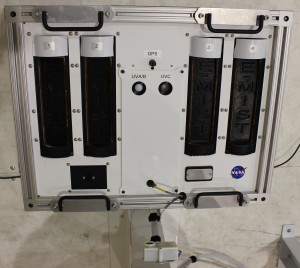
Pre-launch photo looks down on the E-MIST payload from the top of the balloon gondola at Ft. Sumner, New Mexico. Several instruments/sensors and four sample-holding canisters can be seen on the front face of the payload.
Credit: NASA
The E-MIST hardware system was developed at NASA’s Kennedy Space Center in Florida. The E-MIST hardware was successfully flight tested in 2014.
The upcoming sendoff into the stratosphere will mark the second flight of the E-MIST hardware — the first full science mission using the system — is from NASA’s Columbia Scientific Balloon Facility in Fort Sumner, New Mexico.
How to watch the flight online!
During the experiment, the public can watch the progress of the flight unfold by following the links to Fort Sumner Operations from NASA’s Columbia Scientific Balloon Facility website at:
http://towerfts.csbf.nasa.gov/
For video on the launch day: click “Near Real Time Video” under “Fort Sumner Operations.” Then click on “Fort Sumner UStream Video Feed.”
For real-time payload position information on the launch day: click “CSBF Test Flight II” listed under the section “Fall 2015 Flights Below.”
Busy launch center
The balloon launching center has been busy!
On Friday, September 25, 2015, NASA’s Radiation Dosimetry Experiment, or RaD-X, was launched and landed today, ending its mission.
RaD-X is designed to provide first-time indications of how cosmic rays deposit energy at the top of atmosphere – an activity that produces showers of additional particles that increase the energy deposited where commercial airlines fly.
This experiment is crafted to improve NASA’s Nowcast of Atmospheric Ionizing Radiation for Aviation Safety (NAIRAS) model, which is currently used by public and private entities for informed decision-making about radiation exposure safety for flight crews, the general public, and commercial space operations.
NASA will detail a major science finding from the agency’s ongoing exploration of Mars during a news briefing at 11:30 a.m. EDT on Monday, Sept. 28 at the James Webb Auditorium at NASA Headquarters in Washington.
The event will be broadcast live on NASA Television and the agency’s website.
News conference participants will be:
— Jim Green, director of planetary science at NASA Headquarters
— Michael Meyer, lead scientist for the Mars Exploration Program at NASA Headquarters
— Lujendra Ojha of the Georgia Institute of Technology in Atlanta
— Mary Beth Wilhelm of NASA’s Ames Research Center in Moffett Field, California and the Georgia Institute of Technology
Resources
For NASA TV downlink information, schedules and to view the news briefing, visit:
The event will also be carried live on:
The imaginative folks at Foster + Partners/New York noted today that they are amongst 30 finalists for the 3D Printed Habitat Challenge organized by America Makes and NASA.
This contest, previously reported by Inside Outer Space, is asking for ideas to develop a settlement on Mars constructed by an array of pre-programmed, semi-autonomous robots prior to the eventual arrival of Mars-landing crews.
Foster + Partners/New York envisions a robust 3D-printed dwelling for up to four astronauts constructed using regolith – the loose soil and rocks found on the surface of Mars.
Explains a Foster + Partners news release: “The compact 93 square meter habitat modules “combines spatial efficiency with human physiology and psychology, with overlapping private and communal spaces, finished with ‘soft’ materials and enhanced virtual environments, which help reduce the adverse effects of monotony, while creating positive living environment for the astronauts.”
Minimal human input
The proposal envisions the habitat delivered in two stages prior to the arrival of the astronauts.
First, the semi-autonomous robots select the site and dig a 5 foot (1.5 meters) deep crater, followed by a second delivery of the inflatable modules which sit within the crater to form the core of the settlement.
“Given the vast distance from the Earth and the ensuing communication delays, the deployment and construction is designed to take place with minimal human input, relying on rules and objectives rather than closely defined instructions. This makes the system more adaptive to change and unexpected challenges – a strong possibility for a mission of this scale,” the design company statement explains.
“Diggers,” “Transporters,” and “Melters”
Three different kinds of robots are parachuted to the surface of Mars, each performing a specialized task within the large-scale Regolith Additive Construction process.
The larger ‘Diggers’ create the crater by excavating the regolith, which the medium-sized ‘Transporters’ then move into position over the inflatable habitat modules layer by layer.
The loose Martian soil is then fused around the modules using microwaves – the same principles involved in 3D-printing – by several small ‘Melters’.
The fused regolith creates a permanent shield that protects the settlement from excessive radiation and extreme outside temperatures.
“The separation of tasks amongst the large number of robots, and the modularity of the habitat means a high level of redundancy is incorporated within the system – if one robot fails, or a single module is damaged, there are others that can fulfill its task, increasing the chances of a successful mission,” the designers conclude.
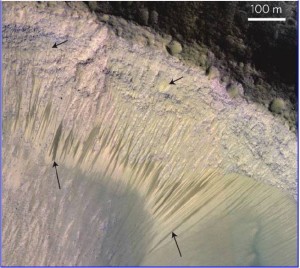
NASA Mars Reconnaissance Orbiter’s HiRISE image of recurring slope lineae (RSL) in Melas Chasma, Valles Marineris. Arrows point out tops and bottoms of a few lineae.
Credit: NASA/JPL-Caltech/University of Arizona
What are they?
Mars-circling spacecraft have spotted at low and middle latitudes on the planet dark, finger-like features that creep down steep martian slopes in warmer months and then fade away in cooler months.
These features fade when inactive, and recur annually at nearly the same location over multiple martian years. What’s behind this phenomenon remains puzzling. No guess as to what they are and why they occur yet satisfies all observations.

A work in progress chart of known recurring slope lineae (RSL) sites. This global map of fully and partially confirmed RSL sites documented by end of 2013. Simple cylindrical map projection.
Credit: Used with permission from Rummel, J. D., et al., “A New Analysis of Mars “Special Regions”: Findings of the Second MEPAG Special Regions Science Analysis Group (SR-SAG2)
Whatever their true nature, they are now unceremoniously called “recurring slope lineae” – or RSL for short. Okay, that’s scientific wordiness.
Perhaps think of them more like “squirts on Mars.”
For my new story on this intriguing feature on the Red Planet, go to:
Mars’ Mysterious Dark Streaks Spur Exploration Debate
by Leonard David, Space.com’s Space Insider Columnist
September 23, 2015 07:11am ET
http://www.space.com/30618-mars-water-streaks-rsl-mystery.html
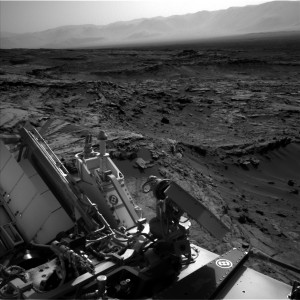
Curiosity Mars rover used its Navcam Left B camera to acquire this image of surrounding and distant terrain on September 20, 2015, Sol 1110.
Credit: NASA/JPL-Caltech
The Curiosity Mars rover has experienced some rough driving.
A drive on Sol 1111 was cut short after a little over 15 meters.
According to Ryan Anderson, a planetary scientist at the USGS Astrogeology Science Center and a member of the Curiosity team, “we were driving over rough terrain and part of the rover’s suspension exceeded the allowed amount of tilt.”
Anderson adds that this is not a physical limit, just a threshold in the software that tells the rover to stop and check with Earth to be safe.
“The rover is fine and we plan to drive again in the Sol 1112 plan,” Anderson noted on Monday. “Meanwhile we are trying to decide where in the area we want to drill to maximize the science return. There are a lot of options because we’re surrounded by interesting geology!”
Potential drill target
After the drive, post-drive imaging is on tap to allow scientists to choose targets on Wednesday.
Dates of planned rover activities are subject to change due to a variety of factors related to the Martian environment, communication relays and rover status.

Future human Mars from using Hypersonic Inflatable Aerodynamic Decelerator (HIAD) technology.
Credit: NASA/Langley
Future Mars missions would greatly benefit from using Hypersonic Inflatable Aerodynamic Decelerator (HIAD) technology.
HIAD-based entry vehicles that generate lift can provide additional mission flexibility.
NASA’s is on the hunt for teams of undergraduate and graduate students studying in fields applicable to human space exploration (i.e., aerospace, electrical, and mechanical engineering; and life, physical, and computer sciences).
Wanted: innovative ideas
The initiative is called the Breakthrough, Innovative and Game-changing (BIG) Idea challenge. BIG is supporting NASA’s Game Changing Development Program (GCDP) efforts designed to rapidly mature innovative/high impact capabilities and technologies for infusion in a broad array of future NASA missions.
This GCDP-sponsored engineering design competition seeks innovative Ideas from the academic community for generating lift using HIAD technology.
In 2016, up to 4 teams may be chosen to compete at the BIG Idea Forum at the NASA Langley Research Center in Hampton, Virginia.
Each team will receive a monetary award to facilitate full participation in the BIG Idea Forum. The top winning team members will receive internship offers for the following summer from GCDP.
More information
The BIG Idea Challenge is managed by the National Institute of Aerospace on behalf of NASA.
Note that there is an optional deadline of October 9, 2015 to submit a Notice of Intent to take part in the challenge.
For more information on this challenge, go to:

China’s Moon program intends to support a lunar sample return in 2017.
Credit: Chinese Academy of Sciences
China’s powerful Long March 5 carrier rocket has been shipped from North China’s Tianjin port. The shipment signals a step toward a rehearsal of the projected 2017 liftoff of the Chang’e 5 lunar mission.
The booster has been designed by China Academy of Launch Vehicle Technology with the China Aerospace Science and Technology Corporation.
The first shakeout flight of the Long March 5 is slated for next year.
According to China’s Xinhua news agency, the Long March 5-boosted Chang’e 5 lunar mission will complete the last chapter in China’s three-step Moon program: orbiting, landing and sample return.
Complex mission
The Chang’e 5 mission is complex, one that will include automatic sampling of lunar material, launch the specimens from the Moon, then makes an automatic docking with a return stage high above the lunar surface, that then hauls the goods back to Earth.
As for the upcoming booster drill, it will be carried out in a launch site that involves both the carrier rocket and a probe, said the State Administration of Science, Technology and Industry for National Defense.
The Long March 5 will have a payload capacity of 14 tons to geostationary transfer orbit, the largest carrying capacity in China.
Long March 6 success
In other booster news from China, Xinhua also reports the successful test flight of the Long March 6.
That rocket flew September 20 from the Taiyuan Satellite Launch Center in north China’s Shanxi Province.
The new carrier rocket will be mainly used for the launch of micro-satellites, according to Chinese authorities. This first test flight of the rocket carried 20 small satellites into the space for space tests – marking a new record high for China in one space shot.
Notes the informative SinoDefense website, the new rocket fills a launch capacity gap in the existing Chang Zheng launch vehicle family – and is
in the same class as the European Space Agency’s Vega and the Russian Angara-1 boosters.
Environmentally friendly
Zhang Weidong, designer-in-chief at the Shanghai Academy of Spaceflight Technology with the China Aerospace Science and Technology Corporation, said the new rocket also “reformed the way carrier rockets are tested and launched in China,” as reported by Xinhua.
The loading, testing and positioning of the Long March 6 was completed in a horizontal position, before it was lifted upright for launching, Zhang said.
According to Wang Jianshe of Aerospace Science & Technology Corporation, the Long March 6 is environmentally friendly. The engine uses liquefied oxygen and diesel that produce carbon dioxide and water.
“This won’t pollute the environment,” Wang said, as reported by China’s CCTV.
